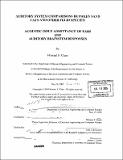Auditory system comparisons between sand cats and other felid species : acoustic input admittance of ears and auditory brainstem responses
Author(s)
Chan, Howard F
DownloadFull printable version (10.07Mb)
Other Contributors
Massachusetts Institute of Technology. Dept. of Electrical Engineering and Computer Science.
Advisor
William T. Peake an John J. Rosowski.
Terms of use
Metadata
Show full item recordAbstract
The sand cat, one species of the cat family, is found only in deserts and has unusually large ear canals and middle-ear air cavities. Recent work has shown that sand cat ears absorb acoustic power at low frequencies (<1 kHz) better than those of domestic cats (Huang et al. 2002). In this thesis, we test this hypothesis by comparing acoustic input- admittance, which determines acoustic power absorption, and thresholds of auditory- brainstem responses. In a zoo, measurements were made in 37 ears of 23 anesthetized specimens, including sand cats and five other felid species. Sand cats have lower mean thresholds at frequencies between 0.25 and 5 kHz by 6-9 dB than other felid species measured. However, the mean power absorption does not differ significantly. The results are consistent with the hypothesis that sand-cat hearing is unusually sensitive, but this specialization is not associated with increased power absorbed at the tympanic membrane.
Description
Thesis (M. Eng.)--Massachusetts Institute of Technology, Dept. of Electrical Engineering and Computer Science, 2005. Includes bibliographical references (leaves 81-82).
Date issued
2005Department
Massachusetts Institute of Technology. Department of Electrical Engineering and Computer SciencePublisher
Massachusetts Institute of Technology
Keywords
Electrical Engineering and Computer Science.